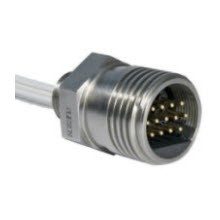I went with the solid contacts, which are more expensive and require a more expensive crimp tool, but that's a lot easier than the stamped and formed contacts to assemble. The crimper is pretty idiot-proof as far as getting everything lined up and solidly crimped.
Comparing the Weather Pack and Deutsch, I do like that you can use multiple wire gauges in the same Weather Pack connector by just changing the connectors and seals on the Weather Pack - for Deutsch you have to use different connectors (DTM for 16-24GA, DT for 14-18GA, DTP for 10-14, DTHD for 6-14GA). The downside to that flexibility is that the Weather Pack connectors are much bulkier for smaller situations - the connector is the same size whether you're doing 20GA or 12GA, just the seal and connector change. It can also be difficult to tell the connectors apart unless you really look at them - the number and size of the tangs that grip the wire are the only difference.
Fussy... I think that is my best comparison of the Weather Pack to the DT/DTP stuff.
The end result is ok, but getting there is... fussy... Well, and the end result is bulky.
With the Deutsch, you put the pin in the crimper and adjust the stop to bring the pin up flush. There is a go/no-go tool to set the tension on the crimper (in the crimper in the photo above). With the crimper set, strip your wire, stick it in the pin, and crimp. Push your pins into the connector, slide the locking wedge in place, and you're done.
As noted above, for the Weather Pack you have to align everything each time. Strip your wire, feed the terminal seal onto it, put a terminal on the wire, and crimp the back ears onto the seal a bit with your fingers so that everything holds together long enough to get it into the crimper. The crimper die has a "step" in it because there are the ears that crimp around the bare wire and then the back ears that crimp around the seal and the wire insulation. Too far forward and the back ears of the bare wire legs don't get crimped. Too far back and the portion to crimp the bare wire ears cuts into the seal. If you get all that right, you probably also have to adjust the tension on the crimper to get it to fully crimp the ears. With the connectors on the wires, push them into the connector and then snap the "keeper" down to lock things together.
I couldn't get the crimper to cleanly crimp the ears, so had to crimp first with one size up to get things going in the right direction and then crimp again with the proper size. Otherwise it would twist the connector and deform it. Also, the connectors for different gauges are determined by how many bare wire ears and how long the ears are on each one. The 20-18 ga ones have three ears, the 16-14 ga ones have two short ears, and the 12 ga ones have two longer ears. The short and long ones you pretty much have to compare side by side to see which are which. Of course, a few had gotten mixed up...
You can use stamped Deutsch connectors as well, but the connectors are different sizes and are more visually different. Still, I'm glad I went with the solid terminals after this experience with the stamped ones.


